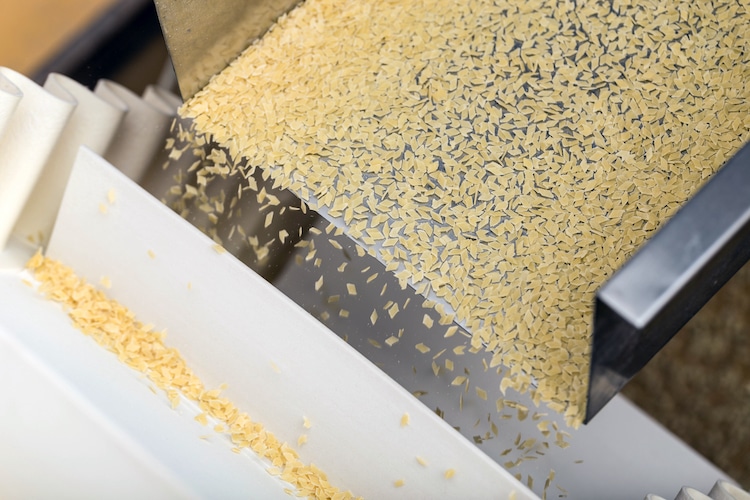Vibratory Conveyors
Vibratory conveyors use vibrations to move bulk materials. These conveyors are commonly used in industries such as mining, pharmaceuticals, food processing, and agriculture, where the efficient handling of materials is critical to maintaining productivity. (Looking for vibratory feeders? Go Here.)

Types
- Electromagnetic Vibratory Conveyors: Electromagnetic vibratory conveyors are commonly used to handle fine powders, granules, and other materials that require precise control of the conveying speed. These conveyors use an electromagnetic drive to create a linear vibratory motion that moves the material forward. The advantage of this type of conveyor is that it can be easily controlled and adjusted to suit specific material handling requirements.
- Mechanical Vibratory Conveyors: Mechanical vibratory conveyors use a mechanical drive to create vibrations that move the material forward. These conveyors are commonly used to handle heavy or bulky materials that require more force to move. They are often used in mining, quarrying, and construction industries to transport large quantities of materials over long distances.
- Spiral Vibratory Conveyors: Spiral vibratory conveyors are designed to handle materials that are difficult to move using conventional conveyors. These conveyors use a spiral motion to move the material forward, allowing them to handle materials with a high viscosity or materials that tend to stick together. The spiral motion also helps to ensure that the material is evenly distributed across the conveyor, reducing the risk of jams or blockages.
- Tubular Vibratory Conveyors: Tube vibratory conveyors are commonly used to transport delicate or fragile materials that require gentle handling. These conveyors use a tube-shaped trough that vibrates to move the material forward. The advantage of this type of conveyor is that it can be designed to suit specific material handling requirements, including the size and shape of the material being transported.
- Vibratory Screen Conveyors: Vibratory screens are a type of vibratory conveyor that are designed to separate materials based on their size or shape. These conveyors use a series of screens or mesh panels that vibrate to separate the material into different sizes. The advantage of this type of conveyor is that it can be used to separate materials that would be difficult or impossible to separate using other methods. Looking to screen but not move? See vibratory screeners here.
Benefits And Drawbacks
Many benefits and drawbacks of vibratory conveyors will depend on the product. For example, strong but brittle products will find vibratory conveyors much more gentle than others, while friable materials will find them unacceptably rough. Similarly, there is a conveyor slope for each product after which vibratory will become more efficient than belted. If there’s any grey area in your application, give us a call or fill out the form below to know for sure what will be best.
Benefits
- Increased Efficiency: Vibratory conveyors are designed to move materials quickly and efficiently, which can help to increase productivity and reduce downtime. These conveyors are often used in high-volume production environments where the efficient handling of materials is critical to maintaining productivity.
- Reduced Maintenance: Vibratory conveyors are often designed to be low-maintenance, which can help to reduce the overall cost of ownership. They are typically made from durable materials and require minimal lubrication or other maintenance.
- Customizable: Vibratory conveyors can be designed to suit specific material handling requirements, including the size and shape of the material being transported, the conveying speed, and the location and orientation of the conveyor. This customization can help to ensure that the conveyor is optimized for the specific needs of the application.
Drawbacks:
- Noise: Vibratory conveyors can generate a lot of noise, especially if they are not properly maintained. This can be a problem in a factory or warehouse setting where noise levels need to be kept to a minimum.
- Limited capacity: Because vibratory conveyors can only be at so great a slope without materials moving at no vibration, there is a relatively low cap on how fast the material can move when vibration is at maximum, compared to other methods.
Why ABM?
ABM is more than just a connection to OEMs. With over 20 years of experience in the industry, we have built a reputation for providing high-quality, reliable, and effective conveying solutions to a wide range of industries.
With a team of experienced engineers and technicians, we provide customized solutions to meet the specific needs of our customers. We work closely with you to understand your requirements and recommend the most suitable conveyance configuration for your application.
We offer ongoing service and maintenance for our packaging systems to ensure they continue to operate at optimal performance. Our technicians are knowledgeable and experienced, and are available to provide on-site maintenance, repair and support services.
Whether you are looking for a single piece or a cohesive system, ABM Equipment can help scale and automate your process. Contact us below to learn more about our services and how we can help you achieve your production goals.
